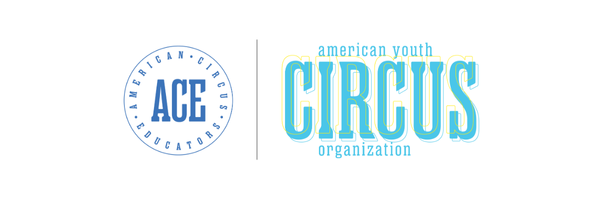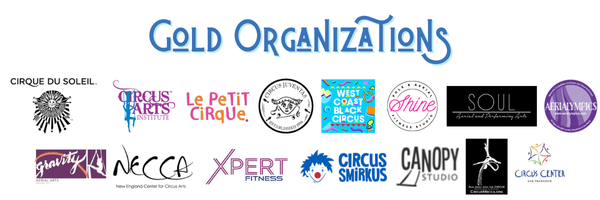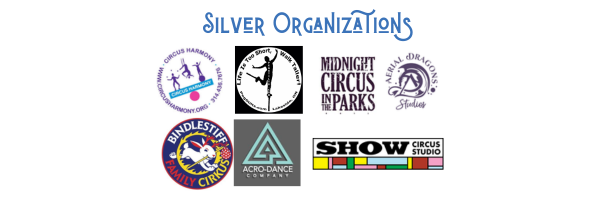I’d like for the aerial community to really hold on to the idea that we are interconnected and that we need to support a high standard of learning, of safety, and of ethics so that we’re giving young professionals the strongest platform to launch from and create the careers that will continue to inspire everyone else practicing this art form.
Historical Background
Aerial disciplines were of course part of the traditional circus arena in origin, and so for a long time, being in the circus was the only way to become part of the circus. Aerial work was considered a high-status act, so training was a privileged exchange between performer and apprentice (often kept inside families) and outsiders had to commit to the touring life to be given an opportunity to learn. Training happened with the sole goal of progression to a performance level, and innovations happened slowly as there were few outside references.
As the circus world gradually opened up to more aspiring artists with the development of contemporary circus, schools began forming as well, offering classes to both aspiring performers and recreational aerialists from more varied backgrounds. However, there was still definitely a tradition within this. Learning remained a hands-on, personal experience with a coach which resulted in close bonds between trainers, performers and fellow students, and with much of the focus still on professional-quality skills and acts being nurtured within a small niche industry.
Although it is an art form, aerial work is also, at its roots, a paid profession; that is the other half of the history of how these disciplines and the practice of instruction developed. High-caliber artists earn their living through performance, which is typically an endeavor that can only be pursued for a limited timespan. Those artists are the ones who will invest the most financially, emotionally and physically in reaching that level, and also the ones who by virtue of pounding out 7-10 shows per week are taking on the most risk.
There isn’t a single performing professional aerialist who can’t name a good friend or co-worker who has been very seriously injured on the job. The reality is that even for highly trained professionals, accidents happen. The risk of a catastrophic accident is statistically small but cannot be ignored. That means that there is a *great* deal at stake, personally and financially, for performing artists in how the industry operates at the professional echelon. The social conventions around teaching and performing have been developed in large part with respect to that.
Training, Technology and Community Evolution
Using video feedback to evaluate your own work really only became common in the 1990s, as few people prior to that could afford recording devices—before that, you relied entirely on your coach’s eye. Even archival footage of other aerial performers was only available in rare enclaves, so there was little opportunity to base your technical development on others’ work even if it had been considered socially appropriate. But it wasn’t. You learned as established technical vocabulary only what people were consciously choosing to share with you. Pursuing training at a professional level in this way was (and still remains) a considerable financial and physical investment, as it involves being where the teachers are and paying for hundreds of hours of their time and studio time to push technical boundaries.
The explosion of popularity of aerial as a fitness and recreational trend along with social media and technology in the last ten years has really upended a lot of the historical framework of coaching and learning aerial disciplines. As late as the early 2000s, most producers and shows still preferred to receive a hard-copy DVD of an artist’s promotional material. The rise of the internet as a means to propagate promotional material was incredibly swift and had far-reaching consequences. By 2008 most performers had switched exclusively to online platforms to reach the people involved in casting. YouTube was one of the few early forums able to host large video files, and so it was commonly used for putting up act videos, particularly full and unedited performances.
The unintended side effect of this switchover was that instead of a handful of promoters seeing your act for consideration in their programming, hundreds and then eventually thousands of YouTube watchers and internet users could peruse your body of work, searching for keywords to hone their results. The community morphed, ballooning within a handful of years to include increasingly tangential individuals and groups. For the first time, people started looking at professionals’ act videos not simply as art to appreciate, but as potential tutorials for their own development, even though the artists themselves would in most cases have strongly discouraged such use.
Rapid Shifts
We’ve now seen a seismic shift in this broader aerial culture, especially with the more recent expansion of aerial work into the pole community and with the popularity of video/photo platforms like Instagram. The pole community has adopted disciplines like aerial hoop and aerial silks largely in a fitness/recreational and competitive context in the last few years, which is a drastic change from the way the circus community has traditionally worked. While competitive festivals do exist in the circus world, they are overwhelmingly for professional level artists that compete across all disciplines using a subjective scoring system. So between the emerging genre of fitness/recreational pole and circus there has also emerged a large gap in attitude towards proprietary moves, research, creative content etc.
Much of the contemporary circus community acknowledges a loose 1-3 year rule, where artistic and technical innovations by an artist are left alone for that period depending on the circumstances of the artist and the degree of innovation. No one will replicate the moves unless they undergo significant transformation—merely reordering a sequence or modest adjustments to form and pacing are not considered sufficient. Leaving new material alone for a period of time gives the artist in question leeway to financially benefit from having created something unique in a marketplace that is increasingly competitive as more and more people from various backgrounds have been seeking out professional career experience as aerialists. Again, the emphasis is on heavy initial artistic (and financial) investment being directly linked to career advancement and financial remuneration as a stage artist.
By contrast, for most pole practitioners and post-circus aerialists, career advancement isn’t measured on stage in show pay. It’s earned in studios by teaching, or increasingly also in receiving revenue as an Instagram “influencer.” Especially for someone who measures income in IG followers, the reality of the cost of investment by a performing artist in creating new technical material is very far removed. For influencers, new income is a mere copy-and-paste away, and they don’t necessarily see how their actions have a tangible impact on another artist’s earning potential. Effectively, in the rapid expansion of the aerial genre and its practitioners, the disciplines were co-opted, but not the moral framework that came with them, and this has been an ongoing source of contention for the last several years now as the circus community tries to protect its artists’ safety and pay standards.
Identifying Authoritative Content
Circus has long been a genre that has defied any attempt to regulate pay or to certify or unionize workers. The plus side of this was the artists and coaches felt free to negotiate better pay and work standards based on their expertise. The downside, of course, is that when someone begins undercutting the market, unless the marketplace is small enough that the other workers can keep out those who undermine safe or fair work conditions, there is little recourse.
The ballooning within the aerial community of aspiring performers has had exactly that effect in the last decade, freezing or lowering base pay rates and working conditions across much of the continental US, and now in international markets—particularly newer markets where safety standards haven’t been established. Realistically, many of the people doing the hiring of performers or beginning their aerial journey as students are ill-equipped to judge the competency of the professionals they are supposedly interacting with. So underbidding and lack of rigorous qualifications has become a glaring problem for emerging professionals both in performance work and in education.
Authoritative content used to be established by the word of mouth within the professional community. Now it’s legitimately hard to judge who can capably identify a qualified recreational coach, as it’s not something standards really existed for previously. Circus professionals have their own idea about how training should be pursued, but realistically, when the end goals are markedly different (as in the aerial dance, recreational aerial or pole communities) the methods may differ to a degree as well.
Circus choreography is based on performance of visible risk moves, and therefore anyone teaching aerial disciplines in a pole or aerial dance studio should be very cautious about borrowing that vocabulary from circus practitioners without adequate technical understanding of how to manage those risks. Similarly, students working within those environments should be aware that the art forms have considerable overlap, but are not interchangeable in terms of training and development.
Experienced artists and coaches tend to acknowledge risk and shades of grey and differing approaches to technique and their relative strengths and weaknesses openly. They can offer cogent arguments for why they would have a preference for teaching a particular way, not including certain moves in the curriculum, or refusing unsafe requests. They can usually also offer examples of how their coaching technique has evolved over years in response to observation and hands-on experience.
For promoters and students working with the broader aerial community, I think it’s going to remain difficult to know how to evaluate expertise for a while. Little by little, consumers of performance or education are getting more information passed down about what questions to ask—Is there liability insurance? Who rigged this equipment? What kinds of mats are appropriate for this?—but it will take a while for these kinds of questions to become more common as the available choices continue to multiply.
Respect for Intellectual Property
The circus industry (both traditional and contemporary) is overwhelmingly white, young, and thin. The contemporary side of the industry particularly is one of privilege, as those with access to expensive intensive training programs are usually the ones who can excel the fastest in an industry where youth and stereotypical beauty hold a huge cachet. Many companies still look at minority performers and think “oh, but if we hired you we would need to create a specific role for you.” This has been said personally to friends of mine. So minority and atypical performers (trans, bigger women, performers of either gender in a discipline less typical) often face a particular kind of discrimination in casting where they need to present unique performance material along with their unique look in order to prompt directors to look outside the box.
When these performers have their material copied and disseminated to the broader aerial community, it has a disproportionately negative effect on their ability to get hired. Within weeks or months dozens of other Instagram influencers and aerialists may be incorporating their moves or sequences into 30-second video bites, rather than having done the hard work to develop the moves as part of a coherent 5-6 minute act—and yet the end result is that the uniqueness is gone.
So even if it’s small transitions or simple moves, the fact that it’s new means it shouldn’t be copied without the artist’s permission in general, but especially with artists who may face any kind of visible discrimination. Although you may not be a professional, your Instagram following takes cues from you and your posting another artist’s material effectively declares it part of the common lexicon, making it available to thousands of aerialists worldwide. This is why many professional aerialists avoid posting with commonly researched or reshare hashtags—and those who do use them still struggle to have followings equal to those who have time and resources (as from another job) to enable them to dedicate to building a following, instead of building an act.
Concerning and Positive Trends within Social Media and in the Community
As I said, one of the most concerning trends I see within social media is the “borrowing” or “inspired by” trend where aerialists copy the unique new moves or apparatus of other aerialists (particularly performers) without asking first. “Inspired by” particularly often looks like a direct copy of an entire sequence or section thereof. It’s really not appropriate to do that with professional artists’ material from an ethical standpoint unless you have their permission, beyond which there are always unresolved questions of technique, placement and risk that less-experienced aerialists may not be aware of. Unless a professional artist has clearly indicated that they are sharing their work with the intent for other people to try it, and have indicated how they’d like to be credited, that’s not what it’s there for.
I also see a trend of racing to the finish line rather than taking the time to develop vocabulary and the corresponding strength and mobility that comes with it. Some aerialists start training neck hangs by themselves without understanding where the body is meant to be engaged or what warning signs indicate you are placing pressure on the ocular nerve. I also see many more young aspiring aerialists these days with dysfunctional flexibility—reduced flexion in the lower back and extremely overdeveloped shoulders with a resulting loss of mobility—caused by poor foundational training and jumping ahead to skills they weren’t ready to train yet, and have to work with them on basic conditioning and body placement to help correct this.
The analogy that I use is that doing aerial work is like learning to walk. It takes us 3-4 years from birth to start getting it right, and it’s a slow process with lots of intermediary steps. Crawl first, run later. The difference is that when a toddler falls the consequences are relatively minor. The ground is close! So with aerial work, people—especially teens and young adults—need to keep in mind that progress is a marathon, not a sprint.
One of the positive things I see in the online community is that as aerial training/performance opportunities are spreading, more people are asking questions and speaking up if they see unsafe or unprofessional practices happening. I also see a lot of professionals connected to the community giving back. Performers, high level coaches, riggers etc are being very generous in sharing information, advice, anecdotes and in general trying to contribute in positive and non-confrontational ways.
It is challenging for longstanding professionals in the industry when we are asked for free advice and then see people actively ignore or dismiss the answers they get, especially when the consensus is overwhelming as to certain safety standards from those of us who have had sustainable and healthy careers doing what we do. But I see more and more of us trying to take the high road and, rather than letting their frustrations leak all over the internet when that kind of response happens, disengaging, taking a break and letting other people whose patience hasn’t been exhausted fill in the breach. That really is a trend for the better.
If there were one thing I could change within the aerial community, it’s just to give people more context of what it’s like trying to become and/or stay a full-time performer.
Becoming a professional performer is a brutal grind, and it takes luck to succeed as well as determination and the right physical and professional skill set. Bridging the gap between having talent and ambition and really getting your feet under you takes years, years where you’re extraordinarily vulnerable financially and physically. So I’d love for the greater community to really take some time to consider how their practice can have repercussions for working artists and their needs.
Aspiring artists will spend 4-5 years training and gigging early on where they could easily have earned more working at Starbucks, but can’t afford to give an employer full availability when they need to be training for 15-20 hours per week to develop a vocabulary and act unique enough to stand a chance at the few auditions held these days. They need to network nationally and internationally, because that’s how most castings get filled now, and that’s an expensive investment beyond the costumes and equipment and training time and promo material. And they need to take risks physically to push the discipline further, but there’s still no guarantee that they’ll make it and successfully transition to earning a full-time living as a performer, that they’ll stay healthy doing so, or (even once they’ve established a name in the industry) that they won’t still have lean years when contracts are canceled or projects fall through. It can always happen—even 10 years into your career.
We are living the dream, but the dream, like many careers in the arts, is very precarious, more so because of the physical risk of what we do. So if anything, I’d like for the aerial community to really hold on to the idea that we are interconnected and that we need to support a high standard of learning, of safety, and of ethics so that we’re giving young professionals the strongest platform to launch from and create the careers that will continue to inspire everyone else practicing this art form.
Tanya Burka (@thetanyaburka) is currently on tour with Cirque du Soleil’s TORUK – The First Flight. A graduate of Canada’s prestigious national circus school and a respected professional artist, she has been an active participant in online discussions on aerial matters.


